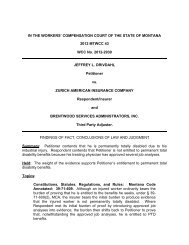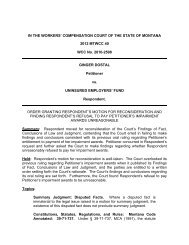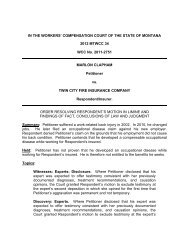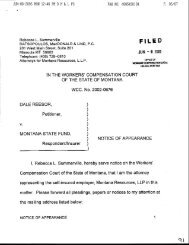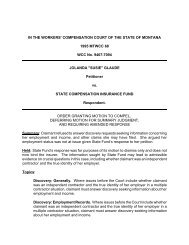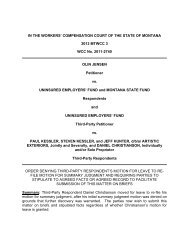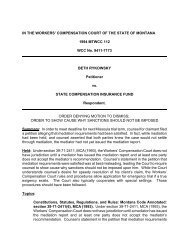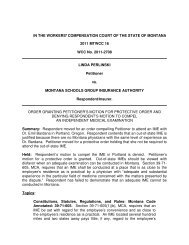2010 MTWCC 16 - Workers' Compensation Court
2010 MTWCC 16 - Workers' Compensation Court
2010 MTWCC 16 - Workers' Compensation Court
Create successful ePaper yourself
Turn your PDF publications into a flip-book with our unique Google optimized e-Paper software.
IN THE WORKERS= COMPENSATION COURT OF THE STATE OF MONTANA<strong>2010</strong> <strong>MTWCC</strong> <strong>16</strong>WCC No. 2009-2266PETE HALLQUIST, d/b/a P & M TRANSMISSIONPetitionervs.INDEPENDENT CONTRACTOR CENTRAL UNITRespondent.FINDINGS OF FACT, CONCLUSIONS OF LAW AND JUDGMENTSummary: Petitioner appeals an Independent Contractor Central Unit decision whichheld that his automotive repair business employed five workers between January 1,2006, and September 30, 2007. Petitioner contends that each of the alleged employeesran an independent business from the same address as Petitioner’s auto repairbusiness, although Petitioner performed administrative tasks for all the independentbusinesses, including collecting funds to pay the shop overhead.Held: It is undisputed that two of the five alleged employees did not work out of thesame shop as P & M Transmission between January 1, 2006, and September 30, 2007.A third alleged employee was indisputably an employee and was paid wages as part ofvocational rehabilitation training until October 2007. The remaining two allegedemployees meet the criteria for independent contractors under the AB test.Topics:Constitutions, Statutes, Regulations, and Rules: Montana CodeAnnotated: 39-71-417. Although the department found two automechanics’ lack of independent contractor exemption certificates to beevidence in support of the department’s conclusion that the mechanicswere employees, this <strong>Court</strong> gives no weight to the lack of exemptioncertificates because the mechanics had a fixed business location andtherefore had no statutory duty to obtain independent contractorexemption certificates.
Independent Contractor: Independent Contractor Exemption.Although the department found two auto mechanics’ lack of independentcontractor exemption certificates to be evidence in support of thedepartment’s conclusion that the mechanics were employees, this <strong>Court</strong>gives no weight to the lack of exemption certificates because themechanics had a fixed business location and therefore had no statutoryduty to obtain independent contractor exemption certificates.Independent Contractor: Elements: Right of Control. The <strong>Court</strong>concluded that an alleged employer had no right of control over automechanics who worked out of the same shop as his business where thealleged employer’s undisputed testimony was that he did not exercisecontrol over the mechanics, and the mechanics were free to come and goas they pleased, could accept as much or as little work as they chose,could give free or discounted work to anyone they wanted and broughtand retained their own clientele. Furthermore, when one mechanicceased to work at the shop with no explanation, the alleged employer didnot demand that he return to work, nor did he offer the mechanic’s spaceto anyone until it was clear the mechanic had no intention of returning.Independent Contractor: Elements: Payment. Where auto mechanicswho were allegedly employees were paid by percentage, the <strong>Court</strong>concluded the factor was neutral in its determination of whether themechanics were employees.Independent Contractor: Elements: Furnishing of Equipment.Several auto mechanics worked out of the same shop and each owned anextensive collection of personal hand tools which were freely shared asneeded. The lifts and air compressor were fixtures of the building andowned by the landlord. The alleged employer owned a parts washerpersonally, and his business owned a spray wash cabinet, both of whichwere used by the other mechanics. While the alleged employer’sownership of some equipment suggests in an almost negligible way thathe had an employer-employee relationship with the mechanics, the <strong>Court</strong>found this entitled to only a small amount of weight given the way that themechanics in this shop shared the work space and their tools.Independent Contractor: Elements: Right to Fire. Where the allegedemployer testified that he did not have the right to evict any mechanic fromthe shop space they shared so long as the mechanic paid his share of theoverhead, and no other evidence in the record indicates that he had theFindings of Fact, Conclusions of Law and Judgment- 2
ight to fire any mechanic, and where, when a mechanic ceased to work inthe shop without explanation the alleged employer stored the mechanicstools indefinitely and did not demand that he return to work, the <strong>Court</strong>concluded the alleged employer did not have the right to fire the allegedemployees.Independent Contractor: Elements. Where two of the four factors weightoward two alleged employees being independent contractors, one factorweighs slightly in favor of them being employees, and one factor isneutral, the <strong>Court</strong> concludes that the control factors indicate the allegedemployees were independent contractors.Independent Contractor: Independent Business. The <strong>Court</strong>determined that an alleged employee who ran a mobile diesel repairbusiness prior to coming to work at the auto repair shop where he wasallegedly an employee, had a large, established clientele which he broughtwith him to the shop, and apparently continued to do diesel repair after heleft the shop, was engaged in an independently established trade,occupation, profession, or business.Independent Contractor: Independent Business. The <strong>Court</strong>determined that an alleged employee who had previously run an autorepair business in a nearby city, had his own clientele, and personallyowned a substantial set of automotive tools was engaged in anindependently established trade, occupation, profession, or business.1 The trial in this matter was held on February 12, <strong>2010</strong>, at the Workers’<strong>Compensation</strong> <strong>Court</strong> in Helena, Montana. Petitioner Pete Hallquist was present andrepresented by Kevin Vainio. Patricia Bik represented the Independent ContractorCentral Unit (ICCU).2 Exhibits: Exhibits 1 through 13 were admitted without objection.3 Witnesses and Depositions: The <strong>Court</strong> admitted the depositions of PeteHallquist, Harvey Caldwell, and Morgan Wyatt with the agreement of the parties. SteveDeBarathy, Pete Hallquist, Scott Moothart, Carol L. Craig, and Edward A. Dawes weresworn and testified at trial.4 Issue Presented: The <strong>Court</strong> restates the issue as follows: 4a Did the ICCU err when it concluded that Harvey Caldwell, KrisLoomis, Morgan Wyatt, Turone Richter, and John Blackwood wereFindings of Fact, Conclusions of Law and Judgment- 3
employees of P & M Transmission for any time during the period ofJanuary 1, 2006, through September 30, 2007?FINDINGS OF FACT5 In January 2008, Scott Moothart (Moothart), field representative for theUnemployment Insurance Contributions Bureau of the Department of Labor andIndustry, was directed to audit P & M Transmission. Moothart testified at trial. I foundMoothart to be a credible witness.6 P & M Transmission came to the department’s attention after Turone Richter(Richter) filed a claim for unemployment. Richter alleged that he had worked for P & MTransmission for $8 per hour, but the department did not have these wages on file.Moothart contacted Petitioner Pete Hallquist (Hallquist), d/b/a P & M Transmission.Hallquist informed Moothart that all the workers at the P & M Transmission shop at 810East Iron Street in Butte were subcontractors and that Hallquist had no employees. 17 Moothart investigated whether the mechanics were independent contractors oremployees of P & M Transmission. Moothart visited the shop, but did not interview anyof the mechanics. Moothart determined that the mechanics performed all their workinside the shop and they all used some equipment which was part of the facility. Hetestified that he saw no evidence that any business other than P & M Transmissionoperated there. Specifically, Moothart did not see any signs for businesses other than P& M Transmission. 28 Moothart looked in the yellow pages and on the internet for advertising for theindividual mechanics, but he did not find any. Moothart testified that the only evidencehe had of independent businesses were city business licenses for some of themechanics and two independent contractor agreements. 39 Moothart reviewed bank statements and cancelled checks from 2006 and 2007.Moothart examined the business records for 2006 and 2007, including time sheets,payroll records, dates and hours worked, withholding information for 2006, and 1099-Rforms for 2007. Moothart noted that the 1099-R forms were unusual because those1 Trial Test.2 Trial Test.3 Trial Test.Findings of Fact, Conclusions of Law and Judgment- 4
forms are usually used for distributions from a retirement account and not for nonemployeecompensation. 410 Moothart determined that none of the individual mechanics had their ownindependently established trade, occupation, profession or business; they did notoperate free from the right of control and direction over the performance of theirservices; and they did not have independent contractor exemption certificates.Moothart determined that the individual mechanics were employees because nonecould meet the definition of independent contractor. 511 Moothart stated that he has no specific examples of Hallquist exerting controlover the mechanics’ work, but he also has no evidence that the mechanics were freefrom the right of control. Moothart alleged that Hallquist had control of the building andhe could preclude people from coming and going or could change the locks. However,Moothart did not know whether any of the other mechanics had keys to the building, andadmitted that any of the mechanics likely could have changed the locks. 612 On August 14, 2008, Moothart completed an audit report for the UnemploymentInsurance Program. In that report, Moothart noted that from May 30, 2006, throughNovember 17, 2006, John Blackwood (Blackwood) received payments from P & MTransmission that totaled $6,900. 7 From April 6, 2007, through September 25, 2007,Morgan Wyatt (Wyatt) received payments from P & M Transmission that totaled$5,800. 8 The parties agree that P & M Transmission paid workers’ compensation andunemployment insurance on Wyatt during that time. 9 From June 2, 2007, throughSeptember 25, 2007, Richter received payments from P & M Transmission whichtotaled $5,041.94. 10 Moothart’s audit report does not report any payments made from P& M Transmission to Harvey Caldwell (Caldwell) or Kris Loomis (Loomis) from January1, 2006, through September 30, 2007.13 Edward A. Dawes (Dawes) testified at trial. I found Dawes to be a crediblewitness. Dawes currently works in the Safety Division of the Department of Labor andIndustry. In 2008, Dawes worked for the Employment Relations Division, Workers’<strong>Compensation</strong> Regulation Bureau, ICCU. At that time, he was asked to determine the4 Trial Test.5 Trial Test.6 Trial Test.7 Ex. 9 at 9.8 Ex. 9 at 10.9 Pretrial Order at 2, Uncontested Facts.10 Ex. 9 at 11.Findings of Fact, Conclusions of Law and Judgment- 5
employment status of Caldwell, Loomis, Wyatt, Richter, Blackwood, and Harry Voss(Voss). Dawes explained that in his position with the ICCU, other state agencies askedhim to determine whether a person was an independent contractor or an employee.Dawes began each investigation by reviewing the information provided by therequesting agency. He would then request completed relationship questionnaires fromthe alleged employees. 1114 Dawes explained that if a worker does not have an independent contractorexemption certificate, the worker is presumed to be an employee. Since none of themechanics had exemption certificates, he presumed most of them to be employees.Because Dawes had personal knowledge that Voss had a separate business in Butte,he concluded that Voss had a mercantile relationship with P & M Transmission. 1215 Once Dawes determined that the mechanics working at 810 East Iron Street hadreceived pay for services, he concluded they were employees. Dawes did not interviewany of the mechanics. Dawes testified that the only evidence he found that indicatedany mechanic had his own business was that some had local business licenses. Healso noted that the mechanics appeared to perform work directly for customers withoutHallquist’s intervention. Dawes did not find enough information to determine how themechanics were paid. One of the relationship questionnaires he received indicated thatthe mechanic was paid a percentage based on the amount of business he brought in tothe shop, but Dawes was unable to determine what the percentage was or the mannerof payment. Dawes’ investigation also revealed that mechanics could apparentlychoose not to work at all during a given month and that the mechanic would not oweanything to the business, but could simply leave his tools sit in the shop. 13<strong>16</strong> Dawes found that neither Caldwell, Loomis, Wyatt, Richter, nor Blackwood held aMontana independent contractor exemption certificate at any time from January 1,2006, through September 30, 2007. 14 Dawes then looked to the “AB test” for guidance. 15Although he noted that the five mechanics’ worker relationship questionnaires were“completed with remarkable similarity,” he noted that the mechanics’ respectivestatements indicated that each was free to operate as he wished, was free to come andgo, and was under no obligation to work if he did not feel like it. <strong>16</strong>11 Trial Test.12 Trial Test.13 Trial Test.14 Ex. 12 at 4.15 See Johnson v. Montana Dep’t of Labor and Indus., 240 Mont. 288, 292 783 P.2d 1355,1359. (1989).<strong>16</strong> Ex. 12 at 6.Findings of Fact, Conclusions of Law and Judgment- 6
17 Dawes testified that he was skeptical of the answers the mechanics provided onthe relationship questionnaires because some of their answers were identical.However, he testified that he ultimately did not base his decision on the questionnaires.Rather, Dawes based his decision on his conclusion that none of the mechanics wouldmeet the criteria to receive independent contractor exemption certificates if he appliedfor one. 1718 Dawes explained that the department has the burden of determining that abusiness exists before it issues an independent contractor exemption certificate. Tomake that determination, the department uses a list of “business-like items” withassigned point values. An applicant must score at least 15 points from the department’slist to qualify for an independent contractor exemption certificate. Dawes testified thatalthough he did not score any of the individual mechanics, he concluded that none ofthem would have scored 15 points or more if he had scored the mechanics. 1819 Dawes also found that P & M Transmission furnished hoists, parts washers, andan air compressor for the mechanics’ use. 19 Regarding the method of payment, Dawesfound:The workers were paid for work on their friends[’] cars and [P & MTransmission’s] customer cars, sometimes the customer paid [P & MTransmission], sometimes the mechanic paid, according to thequestionnaire. The workers had to pay a nominal amount to use the shop.No details of the shop lease/rental agreement were found in theindependent contractor agreement or provided by [P & M Transmission.] 20Regarding the right to fire, Dawes found that each mechanic could terminate hisservices at any time without incurring a contractual liability. 2120 Based on his findings relative to these four factors, Dawes concluded that themechanics did not satisfy the control prong of the independent contractor requirement. 22On February 11, 2009, Dawes issued an ICCU decision concerning the employmentstatus of Caldwell, Loomis, Wyatt, Voss, Richter, and Blackwood for the period of17 Trial Test.18 Trial Test.19 Ex. 12 at 6.20 Ex. 12 at 6. Although Dawes reviewed independent contractor agreements in making his determination,the only independent contractor agreements which were entered into evidence were dated January 1, 2008, and thusare not relevant to this <strong>Court</strong>’s findings as they were outside the audit period at issue.21 Ex. 12 at 6.22 Ex. 12 at 7.Findings of Fact, Conclusions of Law and Judgment- 7
January 1, 2006, through September 30, 2007. 23 Dawes found that Voss sold a part toP & M Transmission and did not provide any services. Dawes concluded that Voss wasnot an employee. 24 Dawes found that Caldwell, Loomis, Wyatt, Richter, and Blackwoodmet the definition of employment “because they held a contract of hire to perform aservice beneficial for [P & M Transmission] and they received payment for theirservice[s].” 2521 Steve DeBarathy (DeBarathy) testified at trial. I found DeBarathy to be a crediblewitness. DeBarathy has owned the real property located at 810 East Iron Street inButte for over 15 years. The property consists of three buildings – a shop, awarehouse, and a small tin building – and some surrounding land. DeBarathy currentlyrents the warehouse to someone who uses it for storage, and an auto wreckingcompany rents the yard. The shop has equipment that belongs to DeBarathy asbuilding fixtures, including a lift and an air compressor, which are available to anyonewho works in the shop. A sign on the shop building says “P & M Transmission.” 2622 The shop consists of a work area, an office, and an adjoining lot. DeBarathytestified that when Hallquist began using the shop, a mechanic named Mike Hanson(Hanson) ran an auto repair business there. Hallquist and Hanson each had his owncustomers and each paid rent separately to DeBarathy. After Hanson left, Hallquistcontinued to work in the shop and he paid rent to DeBarathy. Since that time, Hallquisthas been the only mechanic to pay rent to DeBarathy. 2723 Hallquist pays rent on a monthly basis. DeBarathy does not have a written leasewith any of the individuals or businesses who use the shop, including Hallquist.DeBarathy testified that a steady stream of auto mechanics have come and gone fromthe shop over the years. DeBarathy does not know how the shop operates on a day-todaybasis, but he has always had the impression that each mechanic had his owncustomers. 2824 Hallquist testified at trial. I found Hallquist to be a credible witness. Hallquist hasbeen an automobile mechanic for over 30 years. 29 He runs P & M Transmission as a23 Ex. 12.24 Ex. 12 at 4.25 Ex. 12 at 4.26 Trial Test.27 Trial Test.28 Trial Test.29 Trial Test.Findings of Fact, Conclusions of Law and Judgment- 8
sole proprietorship. 30 Hallquist moved his automotive repair business to the 810 EastIron Street shop in approximately 1998 after Hanson asked him to move in and splitexpenses. Hallquist testified that although he and Hanson worked out of the sameaddress, each ran a separate business and paid part of the overhead. Hansonpreferred that they wrote separate rent checks to DeBarathy, and so Hallquist gaveDeBarathy a check each month to cover his portion of the rent. 3125 Through the time of trial, Hallquist paid the monthly overhead – including rent,electricity, telephone, garbage service, coveralls, credit card terminal, internet service,parts information system, and secretarial services – for the operation of P & MTransmission at 810 East Iron Street. 32 Hallquist testified that the overhead at 810 EastIron Street is too high for one person to profitably run a repair business there.Mechanics can make a profit if they split the overhead. 33 Hallquist pays the overheadfrom the funds received from customers. This includes a parts mark-up and apercentage of the labor charged by each mechanic. 3426 The shop contains three vehicle lifts. One was present in the building whenHallquist began working there. Hallquist installed the other two. They are fixtures andwill remain if Hallquist leaves. 35 Hallquist owns a parts washer, spray wash cabinet, anda brake lathe that are in the shop and available for all the mechanics to use. 36 Thespray wash cabinet and the lifts were purchased via the P & M Transmission businessaccount. 37 Hallquist purchased the parts washer and his tools and diagnostic equipmentpersonally. 38 Hallquist does not believe any of the other mechanics except Wyatt everused the brake lathe. 39 Hallquist also owns a wrecker which is not part of P & MTransmission’s assets. Wyatt uses Hallquist’s wrecker occasionally. 4030 Hallquist Dep. 6:12-18.31 Trial Test.32 Pretrial Order at 2, Uncontested Facts.33 Hallquist Dep. 45:4-12.34 Pretrial Order at 3, Uncontested Facts.35 Trial Test.36 Hallquist Dep. 9:21 – 10:5.37 Hallquist Dep. 67:13-17.38 Hallquist Dep. 67:2-19.39 Hallquist Dep. 10:1-3.40 Hallquist Dep. 66:1-24.Findings of Fact, Conclusions of Law and Judgment- 9
27 Hallquist testified that mechanics commonly share garage spaces in acooperative arrangement such as the one at 810 East Iron Street. 41 Hallquist stated thatevery mechanic who has worked in the shop owned his own hand tools. 42 Theindividual mechanics also owned larger equipment such as welders and torches. 43Hallquist noted that there are commonly-understood “ground rules” to sharing garagespace: for example, mechanics do not borrow tools without permission and they returntools in the same condition as they were when borrowed. Hallquist noted that the toolsrequired for automotive repair are numerous and expensive, and no mechanic ownsevery tool he might possibly need. 44 Hallquist estimated that he personally ownsapproximately $250,000 worth of hand tools and diagnostic equipment. He stated thatRichter owned one of the largest sets of tools in the shop, and estimated its value at$80,000 to $90,000. He estimated that Wyatt owns $30,000 to $40,000 worth of tools. 4528 Hallquist noted that independent mechanics also need to share knowledge, andmost mechanics will advise each other on difficult repair jobs. 46 Hallquist occasionallygave advice to the other mechanics who worked at 810 East Iron Street, but he neverset schedules or told anyone what hours to work. Hallquist testified that all themechanics are free to come and go and have keys to the property. 4729 Hallquist testified that each mechanic who worked at 810 East Iron Street couldorder parts in any manner he wanted, but items purchased through the P & MTransmission accounts received volume discounts. 48 Hallquist knew that Blackwoodhad parts accounts prior to coming to work at the shop, but Blackwood used the P & MTransmission accounts instead of his own because the discounts were better. 49Hallquist authorized the individual mechanics to order parts from various suppliers usingthe P & M Transmission business accounts with the understanding that the mechanicswould pay for those parts in cash. 50 Hallquist testified that the P & M Transmission partsaccounts were also used by other mechanics in Butte. The parts orders were a highenough volume to qualify P & M Transmission for a very favorable discount rate.41 Hallquist Dep. 48:6-22.42 Hallquist Dep. 10:<strong>16</strong>-22.43 Trial Test.44 Hallquist Dep. 52:13-24.45 Hallquist Dep. 52:25 – 53:11.46 Hallquist Dep. 53:19 – 54:6.47 Trial Test.48 Trial Test.49 Trial Test.50 Pretrial Order at 2-3, Uncontested Facts.Findings of Fact, Conclusions of Law and Judgment- 10
Mechanics purchased parts through P & M Transmission because they could orderparts less expensively than they could on their own. By allowing other mechanics touse the parts accounts, Hallquist ensured that enough volume flowed through theaccounts to keep the discounts in place. The situation benefitted P & M Transmissionand all the mechanics who used the accounts. 5130 Hallquist testified that parts purchased through the P & M Transmission partsaccounts had a 30% mark-up to the customer. The parts mark-up went into the “kitty,”along with 50% of the labor cost for any work done in the shop. Each mechanic wouldretain the other 50% of his labor charge. At the end of the month, the money in the“kitty” would be used to pay the overhead for 810 East Iron Street. If the “kitty” was notlarge enough to cover the overhead, Hallquist would pay the difference out of hispocket. Hallquist stated that he was not actually at risk for losing the money he paid outof his pocket, as the mechanics always ensured that if Hallquist paid out of pocket onemonth, he would get reimbursed for that expenditure out of surplus in the “kitty” in alater, more profitable month. If the “kitty” was larger than needed to cover the overhead,Hallquist would divide the remaining “kitty” money between the mechanics, with eachreceiving a share proportionate to the amount he had brought in that month. Hallquisttestified that every mechanic who worked in the shop was entitled to a share of theprofit. 5231 Hallquist testified that none of the mechanics were required to keep set hours.The monthly rent was split according to the number of mechanics working out of theshop. After Hallquist paid the overhead each month, each mechanic received apercentage of the remaining money which was in proportion to the amount of work hehad completed. 5332 Hallquist wrote checks on the P & M Transmission business account to pay eachmechanic a percentage of the labor costs that had been charged to each customer forwork completed by that individual mechanic for that customer. Hallquist calculated thepayment for all mechanics working at P & M Transmission based upon a percentage oflabor costs recorded on the Auto Repair Orders. 5433 Hallquist stated that he did not schedule jobs for the mechanics and he oftenwould not know what jobs were in the shop. 55 If a customer of one of the other51 Hallquist Dep. 19:5-21.52 Trial Test.53 Trial Test.54 Pretrial Order at 3, Uncontested Facts.55 Hallquist Dep. 18:21 – 19:1.Findings of Fact, Conclusions of Law and Judgment- 11
mechanics called to schedule a repair, Hallquist would tell the customer to drop thevehicle off and that the mechanic would get to it as soon as possible. Hallquist statedthat he did not make any commitments to other mechanics’ customers. 5634 Hallquist explained that each mechanic only took in the work he wanted to do. Ifa customer called and Hallquist accepted a job for a mechanic that that mechanic didnot want, Hallquist did the repair himself. If a new customer called, Hallquist placed thatjob on a list for the mechanics to examine. The mechanics were free to take jobs fromthat list. 57 Hallquist could not recall the shop ever having a problem with a mechanicwho did substandard work. As long as each mechanic paid his share of the overhead, itwas not Hallquist’s concern if the mechanic did not take in much work. No mechanicever got pushed out or evicted from the shop. 58 Hallquist testified that he did not havethe right to throw any mechanic off the property so long as he was paying his share ofthe expenses. 5935 Hallquist explained that customers pay for the work on their vehicles after thework is finished, so the mechanic who performed the work would get paid by thecustomer. If a mechanic began a repair but did not finish it, the only mechanic whowould get paid by the customer would be the mechanic who finished the repair. 60Hallquist testified that each mechanic had his own clientele. When a mechanic left, hisclients usually went with him. Most of the mechanics had established businesseselsewhere prior to relocating to the 810 East Iron Street shop. Mechanics were free toset their own prices and could give a customer a discount or perform free or discountedwork for someone if they wished. Mechanics did not have to ask Hallquist for approvalif they intended to charge someone less. 6136 Hallquist admitted that he had some concerns with how Richter ran his business.Richter was slow and deliberate in making repairs and he wanted to charge hiscustomers for the time it took him to do the job, rather than the time the repair shouldhave taken. Hallquist told Richter that he was free to charge his own clientele any wayhe wanted, but that if he was taking repair jobs off Hallquist’s call list, he had to chargea reasonable rate. 6256 Trial Test.57 Hallquist Dep. 18:1-18.58 Trial Test.59 Trial Test.60 Trial Test.61 Trial Test.62 Hallquist Dep. 28:2-21.Findings of Fact, Conclusions of Law and Judgment- 12
37 Hallquist stated that all the mechanics who worked out of the shop were veryprofessional, experienced mechanics, and he never had an issue arise where amechanic was unwilling to resolve a dispute. Hallquist testified that all parts installedwere subject to manufacturer warranties. There was no explicit warranty for labor fromP & M Transmission; however, each mechanic was responsible for resolving anyproblems a customer had with his work. If a mechanic had to put extra time into arepair or replace parts that were improperly installed, the mechanic was responsible forany time or expense incurred. 6338 Hallquist testified that when a customer requests an estimate, it is provided on aP & M Transmission invoice. The mechanic performing the work has the responsibilityto stay within the estimate. If a price was negotiated with the customer, whoevernegotiated the price is responsible for ensuring that the customer is billed the correctamount. Since most customers did not request estimates, invoices are usuallycompleted after the repair work was done. Usually, each mechanic would bring ahandwritten document to Hallquist which listed parts’ costs and labor time. Hallquistthen prepared the invoice to reflect that amount. Hallquist did not receive any direct payfor providing this service. Hallquist stated that it did not take much time for him toprepare the invoices; he simply took the information provided by the mechanic and put itinto a legible form. 6439 Hallquist explained that when a customer came in to pay for a repair, whoeverwas present at the shop would accept the payment. If a mechanic collected moneydirectly from a customer, he would inform Hallquist that he had received those funds,and they would be deducted from the amount owed the mechanic the next time thebooks were balanced. Customers were required to pay their bills prior to taking thevehicle, so mechanics never had to worry about collections. Hallquist stated that whilehe did the calculations each month for how much each mechanic received, themechanics also kept track of their own figures and so each mechanic knew how muchmoney he was owed. 6540 P & M Transmission billed customers for repair work done by all mechanicsworking at P & M Transmission. The individual mechanics also billed some customersindividually rather than through P & M Transmission. 66 Hallquist testified that most ofthe mechanics did not like to handle book work, and so Hallquist wrote out the majority63 Trial Test.64 Trial Test.65 Trial Test.66 Pretrial Order at 2, Uncontested Facts.Findings of Fact, Conclusions of Law and Judgment- 13
of their bills and receipts. 67 Hallquist stated that he functioned more like a secretary orservice writer than like a shop foreman because a foreman typically tells mechanicswhat to do and when to do it, and he did not have any authority to tell the mechanicswhen or how to do their jobs. 6841 Hallquist testified that he and the other mechanics never put much effort intoadvertising their respective businesses because they all had enough work withoutadvertising. 69 Wyatt, Loomis, and Caldwell each advertised his business in somefashion, however. Loomis passed out business cards and distributed flyers at bars andother businesses. Caldwell placed business cards in various parts houses. Until arecent downturn in business, most of Wyatt’s advertising was word-of-mouth. 70 Hallquistexplained that after Caldwell left, he and Wyatt discussed advertising more aggressivelybecause they had difficulty paying the overhead with only two mechanics using theshop. They came up with the idea of advertising the available bay as a rental space forindividuals to work on personal vehicles. 71 Wyatt has been promoting this servicethrough flyers. 7242 Hallquist is not aware of any independent advertising by Blackwood, but heopined that Blackwood had established a large clientele throughout his years as amechanic. Hallquist stated that Blackwood operated a mobile diesel repair businessprior to coming to work at the shop. 73 Hallquist testified that Blackwood preferredworking on diesels and when he left the P & M Transmission shop, he did repair workon diesels exclusively for a period of time. At the time of Hallquist’s deposition, he hadnot seen Blackwood in approximately six months and did not know if Blackwood wasstill working as a diesel mechanic. 7443 Hallquist did not know if Richter did any independent advertising, but he knewthat Richter had run an automotive repair shop in Deer Lodge prior to moving hisbusiness to the shop in Butte. 75 Hallquist stated that the mechanics had the name oftheir own businesses – not P & M Transmission – on their advertising materials. Forexample, Loomis’s cards said “Tungsten Performance” and Caldwell’s cards said “H & J67 Hallquist Dep. 15:13-19.68 Hallquist Dep. 17:18-25.69 Hallquist Dep. 61:7-20.70 Trial Test.71 Hallquist Dep. 61:7-20.72 Trial Test.73 Trial Test.74 Hallquist Dep. 75:14 – 76:4.75 Trial Test.Findings of Fact, Conclusions of Law and Judgment- 14
Mechanical,” and then each had the shop address and phone number and theirrespective cellular phone numbers listed. The flyers which Wyatt has distributed for thenew rental business say “Rent-A-Rack” and do not mention P & M Transmission. 7644 Hallquist now works full-time as a machinist at the Montana DevelopmentalCenter in Boulder and does not spend much time at the P & M Transmission shop. 77 Hehas kept the P & M Transmission business active, however, because the credit cardterminal and telephone service contracts extend into the future and he would have topay penalties to terminate the contracts early. Wyatt uses these services and he alsouses the P & M Transmission checking account. 7845 Hallquist testified that either he or Wyatt pays the shop overhead out of the P &M Transmission business account. 79 Hallquist stated that Wyatt has an equal say inwhatever happens in the shop, including whether to invite a mechanic to use theavailable bay. 80 Hallquist testified that Wyatt has “a virtually equal share in everythingthat is going on around there. He watches out for it as if everything was his very ownbecause essentially, it is.” 81 Hallquist testified, “You might say that everybody that [has]been in there has actually been a partner, but never been a partner on paper.” 8246 Hallquist used to have Carol Craig (Craig) prepare his taxes. Hallquist ceasedusing Craig’s services, in part, because Craig wanted every mechanic in the shop tohave an independent contractor exemption, and because she believed that allowingeveryone to use the P & M Transmission parts accounts was problematic. Hallquist hasnot found a new tax preparer since he ceased to use Craig’s services. As a result, hehas not distributed 1099 forms since 2006. 83 Hallquist, Caldwell and Wyatt have notfiled personal or business federal or state income tax forms for 2006, 2007, and 2008. 8447 Hallquist testified that to the best of his recollection, in 2006, Blackwood workedat the shop, as did a mechanic named Tim Cohlhepp (Cohlhepp). Cohlhepp’semployment status is not a subject of the present case. Richter began working at the76 Trial Test.77 Trial Test.78 Hallquist Dep. 6:24 – 7:9.79 Trial Test.80 Hallquist Dep. 69:13-19.81 Hallquist Dep. 72:21-23.82 Hallquist Dep. 73:2-4.83 Hallquist Dep. 33:1-19.84 Pretrial Order at 3, Uncontested Facts.Findings of Fact, Conclusions of Law and Judgment- 15
shop after Cohlhepp left in early 2007. 85 Hallquist testified that he paid Cohlhepp anhourly wage at Craig’s urging but both Hallquist and Cohlhepp were unhappy with thearrangement. Cohlhepp soon left the shop to run his auto repair business elsewhere. 86When Cohlhepp left, his clientele went with him. 87 Although Richter apparently told theunemployment office that he was paid $8 per hour, Hallquist stated that Richter waspaid 40% of whatever business he brought in each month and Richter never receivedan hourly wage. 8848 During 2007, Wyatt worked as an employee of P & M Transmission while heparticipated in a vocational rehabilitation program. 89 Wyatt was covered byunemployment insurance and workers’ compensation insurance while he was in thevocational rehabilitation program. 90 During that time, Wyatt received an hourly wage. 91Hallquist stated that the only time he performed a supervisory role was when Wyatt wasan employee of P & M Transmission while completing vocational rehabilitation training. 9249 Hallquist testified that one day, he and Wyatt returned to the shop after lunch andRichter was gone. Richter never returned. He did not return Hallquist’s phonemessages. Approximately a month after Richter left, his wife came to the shop andinformed Hallquist and Wyatt that Richter was ill and that she did not know if he wouldbe able to return to work. Hallquist told her that Richter’s tools were safe at the shop foras long as he wanted to store them there. The tools remained at the shop for over sixmonths. 93 Richter died some time after he ceased to work at the P & M Transmissionshop. 94 In November 2007, Caldwell began working in the shop in the space Richterhad previously used. 95 At some point prior to Caldwell’s leaving the shop, Loomis alsoworked there for a brief time. 9685 Hallquist Dep. 12:12-23.86 Hallquist Dep. 24:3-13.87 Hallquist Dep. 15:5-7.88 Hallquist Dep. 27:7-25.89 Trial Test.90 Hallquist Dep. 6:3-7.91 Hallquist Dep. 22:21 – 23:7.92 Hallquist Dep. 5:19-23.93 Hallquist Dep. 29:1-25.94 Trial Test.95 Hallquist Dep. 30:1-5; Caldwell Dep. 6:<strong>16</strong>-17.96 Hallquist Dep. 32:9-12.Findings of Fact, Conclusions of Law and Judgment- <strong>16</strong>
50 Wyatt testified by deposition taken January 8, <strong>2010</strong>. Wyatt testified that he hasan independent contractor exemption certificate from the State of Montana. 97 At thetime of Wyatt’s deposition, he was the only mechanic using the shop at 810 East IronStreet. 98 Wyatt was doing his own billing, advertising, and parts ordering. 99 Wyatt statedthat he gets 40% of whatever work he takes in, and the remaining 60% goes to Hallquistto pay the overhead. 100 When Wyatt gets paid for a repair, he deposits the funds in theP & M Transmission business account. 101 He later calculates his percentage and writeshimself a check. 10251 Wyatt began working with Hallquist at P & M Transmission in 2007 while he wascompleting vocational rehabilitation and learning the automotive repair trade. 103 FromApril 6, 2007, until October 6, 2007, Wyatt participated in vocational rehabilitationtraining as part of his workers’ compensation benefits. During that time, Hallquist paidunemployment insurance and workers’ compensation insurance for Wyatt. 104 OnSeptember 25, 2007, Wyatt obtained a business license from Butte-Silver Bow whichauthorized him to engage in businesses at 810 East Iron Street in Butte. 10552 Wyatt testified that he owns his own hand tools, but the building owns thecompressor and the lift. Wyatt further testified that if any of the mechanics at the shopneeded a hand tool that the mechanic did not personally own, he was free to borrowthat tool from another mechanic’s tool box. 10653 Wyatt testified that when he began working at the shop, Blackwood and someother mechanics worked there. Loomis and Caldwell both began working at the shopafter Wyatt did. 107 On September 26, 2007, Richter obtained a business license fromButte-Silver Bow which authorized him to engage in the business of contract mechanic97 Wyatt Dep. 5:8-13.98 Wyatt Dep. 6:10-12.99 Wyatt Dep. 6:13-17.100 Wyatt Dep. 6:18-24.101 Wyatt Dep. 7:22-25.102 Wyatt Dep. 8:6-7.103 Wyatt Dep. 5:19-24.104 Pretrial Order at 2, Uncontested Facts.105 Pretrial Order at 2, Uncontested Facts. Although the parties agree that Harvey Caldwell and Kris Loomisalso obtained business licenses, they did so after September 30, 2007. Therefore, their licenses are not relevant tothe ICCU decision.106 Wyatt Dep. 11:13-24.107 Wyatt Dep. 9:17 – 10:14.Findings of Fact, Conclusions of Law and Judgment- 17
at 810 East Iron Street in Butte. 108 Richter’s business is identified on the license asPahaska Services. 109 Wyatt testified that he does not believe Richter was ever paid bythe hour at P & M Transmission, but was paid by the job like the rest of the mechanics.Wyatt opined that Richter identified himself as an employee so he could getunemployment benefits. 11054 Wyatt testified that at the time of his deposition, Hallquist had little involvementwith the shop, although he occasionally worked on a vehicle there. 111 Hallquistfrequently refers jobs to Wyatt. 112 Wyatt does not know if Hallquist does any advertisingfor P & M Transmission aside from business cards. Wyatt testified: “It’s pretty muchword of mouth in this town. If you get a good reputation, you don’t need to do nothing,you know, because all your buddies tell their buddies and they tell their friends, youknow, and it just goes.” 11355 Craig, an accountant who previously prepared Hallquist’s tax returns, testified attrial. I found Craig to be a credible witness. Craig has a business degree from theUniversity of Montana. She is not a Certified Public Accountant. Craig preparedHallquist’s tax returns for 2004 and 2005. During those years, Craig did not find anybusiness expenses reported for employees of P & M Transmission, but did findpayments to independent contractors. 11456 Craig has never been to Hallquist’s business and she has never spoken to any ofthe mechanics who work in the shop. To the best of her knowledge, no one other thanHallquist had any financial investment in the business. Craig does not know how theshop ran or whether Hallquist had the right to control the work or schedules of the othermechanics. 11557 The ICCU concluded:Harvey Caldwell, Kris Loomis, Morgan Wyatt, Turone Richter, and JohnBlackwood do not have Montana Independent Contractor ExemptionCertificates or meet the criteria required to apply for the Montana108 Ex.1 at 6.109 Id.110 Wyatt Dep. 13:5-<strong>16</strong>.111 Wyatt Dep. 8:15-21.112 Wyatt Dep. 8:22 – 9:1.113 Wyatt Dep. 9:5-8.114 Trial Test.115 Trial Test.Findings of Fact, Conclusions of Law and Judgment- 18
Independent Contractor Exemption Certificate. The decision of the ICCUis the services provided by Harvey Caldwell, Kris Loomis, Morgan Wyatt,Turone Richter, and John Blackwood for P & M Transmission during theperiod of 1/1/06 to 9/30/07, falls within the definition of employment.Therefore Harvey Caldwell, Kris Loomis, Morgan Wyatt, Turone Richter,and John Blackwood are deemed employees of P & M Transmission. 1<strong>16</strong>58 It is from this ICCU determination that Hallquist appeals. Although the factualfindings and legal conclusions set out in the ICCU’s determination are not binding, noreven entitled to deference, the ICCU’s determination helps frame the issues for the<strong>Court</strong>. 117CONCLUSIONS OF LAW59 Appeals from ICCU determinations are within the jurisdiction of the Workers’<strong>Compensation</strong> <strong>Court</strong>, as provided for in § 39-71-415, MCA. This <strong>Court</strong> reviews suchdeterminations de novo. 11860 In the decision from which Hallquist appeals, the department determined thatfive mechanics – Caldwell, Loomis, Wyatt, Richter, and Blackwood – were employees ofHallquist, d/b/a P & M Transmission, at some point between January 1, 2006, throughSeptember 30, 2007. The evidence in this case has indisputably shown that neitherCaldwell nor Loomis worked at the 810 East Iron Street location in any capacity duringthis time period. I therefore conclude they were not employees of P & M Transmissionduring the relevant time period.61 Conversely, it is undisputed that Wyatt was an employee of P & M Transmissionduring this time period as he participated in a vocational rehabilitation program. Noevidence was presented to suggest that Wyatt worked at P & M Transmission in anycapacity prior to commencing his employment with P & M Transmission. The partiesstipulated that Wyatt remained in this program and was paid as an employee of P & MTransmission through October 6, 2007. Therefore, while I conclude that Wyatt was anemployee of P & M Transmission during the time period at issue, I further note that theevidence shows that Hallquist properly treated Wyatt as an employee during this timeperiod and that Wyatt was covered by workers’ compensation insurance and receivedthe services Hallquist was obligated to provide as an employer. Therefore, I see no1<strong>16</strong> Ex. 12 at 7.117 RAM Montana, Inc. v. Indep. Contractor Central Unit, 2004 <strong>MTWCC</strong> 13, 10.118 Mortensen v.Indep. Contractor Central Unit, 2001 <strong>MTWCC</strong> 38, 3.Findings of Fact, Conclusions of Law and Judgment- 19
issue for which Hallquist should be adversely affected by his employment of Wyattduring the time period at issue.62 As for Richter, Hallquist testified that Richter began working in the shop in early2007. Moothart found that from June 2, 2007, through September 25, 2007, Richterreceived payments from P & M Transmission which totaled $5,041.97. On September26, 2007, Richter obtained a business license from Butte-Silver Bow. Dawes found thatRichter did not hold a Montana Independent Contractor Exemption Certificate at anytime from January 1, 2006, until September 30, 2007. Although Richter filed a claim forunemployment in which he alleged that P & M Transmission paid him $8 per hour as ashop mechanic, Hallquist stated that Richter was paid 40% of whatever business hebrought in each month and Richter never received an hourly wage. Wyatt testified thathe does not believe Richter was ever paid by the hour, and that Richter identifiedhimself as an employee to obtain unemployment benefits. Hallquist’s uncontrovertedtestimony was that Richter owned his own tools, that Hallquist did not know whetherRichter independently advertised his business, that Richter left the shop one daywithout explanation and never returned, and that Hallquist told Richter’s wife that hewould store Richter’s tools, which then remained at the shop for over six months.Hallquist admitted that he told Richter that while he was free to charge his own clienteleany way he wanted, that he had to charge a reasonable rate when accepting jobs fromHallquist’s list.63 Aside from the ultimate question as to whether the mechanics were employees ofP & M Transmission, the only fact in dispute regarding Richter is whether he was paidan hourly wage or on a percentage basis. Although I cannot assess Richter’s credibility,I did find Hallquist to be a credible witness. Except for Wyatt’s situation while he wasparticipating in the vocational rehabilitation program, all of the evidence except forRichter’s representation in his unemployment claim indicates that after Hallquist’sattempt to pay Cohlhepp an hourly wage failed, the mechanics at 810 East Iron Streetwere paid on a percentage basis and not an hourly wage. Therefore, I find it moreprobable than not that Richter was paid on a percentage basis.64 As for Blackwood, the evidence in the record is scant. Moothart noted in hisreport that from May 30, 2006, through November 17, 2006, Blackwood receivedpayments from P & M Transmission that totaled $6,900. Dawes found that Blackwooddid not hold a Montana Independent Contractor Exemption Certificate at any time fromJanuary 1, 2006, until September 30, 2007. Both Hallquist and Wyatt testified thatBlackwood worked at the shop in 2006. Hallquist testified that Blackwood had a largeclientele and may not have independently advertised his business because he was notlooking for more work. Hallquist further testified that Blackwood ran a mobile dieselrepair service prior to working at 810 East Iron Street, and that he returned to dieselrepair after leaving the P & M Transmission shop.Findings of Fact, Conclusions of Law and Judgment- 20
65 Both Moothart and Dawes found Richter’s and Blackwood’s lack of independentcontractor exemption certificates to be evidence in support of their conclusions thatthese mechanics were actually employees of P & M Transmission. However, I do notgive the mechanics’ lack of independent contractor exemption certificates any weight indetermining whether or not they were employees in this case. Section 39-71-417(1)(a),MCA, requires a person who regularly and customarily performs services at a locationother than the person’s own fixed business location to apply for an independentcontractor exemption certificate. It is undisputed that the mechanics all worked at afixed business location – 810 East Iron Street. Therefore, none of the mechanics had astatutory duty to apply for independent contractor exemption certificates.66 An independent contractor determination is reached through a two-step process.First, the <strong>Court</strong> evaluates the control over the worker through the application of fourcontrol factors. Second, the <strong>Court</strong> must determine whether the worker was engaged inan independently established trade, occupation, profession, or business. Both parts ofthe test must be satisfied by a convincing accumulation of undisputed evidence;otherwise, the worker is an employee and not an independent contractor. 119The Control Factors67 An employer means anyone who has a person in service under an appointmentor contract of hire, expressed or implied, oral or written. 120 An individual is in the serviceof another when that other has the right to control the details of the individual’s work. 121In determining control, the <strong>Court</strong> employs a four-part test which guides the inquiry indetermining whether an employer-employee relationship exists: (1) direct evidence ofright or exercise of control; (2) method of payment; (3) furnishing of equipment; and (4)right to fire. 12268 Right or Exercise of Control: The right of control, not the amount of controlactually exercised, is the critical element in determining this factor. 123 Hallquist’suncontradicted testimony was that he did not exercise control over the mechanics.Mechanics were free to come and go whenever they pleased, could accept as much oras little work as they chose, and could give free or discounted work to anyone they119 Wild v. Fregein Constr., 2003 MT 115, 33-34, 315 Mont. 425, 68 P.3d 855; Ramsey v. YellowstoneNeurosurgical Assoc., P.C., 2005 MT 317, 26, 329 Mont. 489, 125 P.3d 1091.120 § 39-71-117(1)(a), MCA.121 In the Matter of Glover, 2002 <strong>MTWCC</strong> 22, 49, citing State ex rel. Ferguson v. Dist, Ct., <strong>16</strong>4 Mont. 84,88, 519 P.2d 151, 154 (1974).122 American Agrijusters Co. v. Montana Dep’t of Labor and Indus., 1999 MT 241, 21, 296 Mont. 176, 988P.2d 782.123 Mortensen v.Indep. Contractor Central Unit, 2001 <strong>MTWCC</strong> 38, 14.Findings of Fact, Conclusions of Law and Judgment- 21
wanted. The mechanics brought their own clientele which went with them when theyleft. The mechanics had keys to the building. Although Moothart theorized thatHallquist could control the mechanics’ access by changing the locks to the building, itappears that any of the mechanics could have changed the locks if they chose to do so.69 Although the mechanics almost always ordered parts through P & MTransmission’s business accounts, they were not required to do so, and the partsaccounts were set up on a cash-only basis so that anyone – even mechanics who didnot work at 810 East Iron Street – could and did order parts using these accounts.Hallquist testified that any mechanic at the shop could accept payment from customersand that any amounts owing would be settled whenever the books were balanced. InRichter’s case, Hallquist testified that Richter inexplicably left in the middle of the dayand never returned. Although Hallquist attempted to contact Richter to find out whathad happened to him, there is no evidence that Hallquist attempted to control Richter bydemanding that he return to work at the shop, or even by offering Richter’s space toanother mechanic until it became clear that Richter had no intention of returning. Fromthe evidence presented, I conclude that not only did Hallquist not choose to exercisecontrol over the mechanics, but that he had no right to do so.70 Method of Payment: When payment is by quantity or percentage, the method ofpayment test largely cancels itself out and becomes neutral. 124 Since I have found thatboth Blackwood and Richter were paid by percentage, this factor becomes neutral in mydetermination of whether they were employees of P & M Transmission.71 Furnishing of Equipment: An employment relationship almost invariably existswhere the purported employer has furnished valuable equipment. 125 In the presentcase, all the mechanics who worked in the shop, including Blackwood and Richter,personally owned extensive collections of personal hand tools. Since no mechanicowned every possible tool, the mechanics freely shared their hand tools with eachother. The lifts and air compressor were fixtures of the building and therefore owned byDeBarathy.72 Hallquist testified that the mechanics used a parts washer which he ownspersonally, and a spray wash cabinet which P & M Transmission owns. Given thatHallquist has worked in the shop at 810 East Iron Street the longest out of all themechanics at issue in the present case, it certainly makes sense that the shop wouldcontain some larger equipment owned by Hallquist. The testimony in this caseindicates that hand tools, equipment, and the building fixtures were freely shared and124 Walling v. Hardy Constr., 247 Mont. 441, 449, 807 P.2d 1335, 1339 (1991) (citing 1C A. Larson,Workmen’s <strong>Compensation</strong> Law § 44.33(b), at 8-106 (1990)).125 American Agrijusters, 33. (Citation omitted.)Findings of Fact, Conclusions of Law and Judgment- 22
used among all the mechanics. While Hallquist’s ownership of some equipmentsuggests in an almost negligible way that he had an employer-employee relationshipwith this mechanic, I find this to be only accorded a small amount of weight in the largerpicture of the way the mechanics in the shop cooperatively shared the work space andtheir tools in order to profitably operate their respective businesses.73 Right to Fire: The power to fire is the power to control. 126 Hallquist testified thathe did not have the right to evict a mechanic so long as the mechanic paid his share ofthe overhead. There is no evidence in the record to indicate that Hallquist had the rightto fire Blackwood or Richter. In fact, when Richter left the shop and did not return,Hallquist attempted to contact Richter and then stored his tools indefinitely. If Hallquisthad the right to fire Richter, he likely would have delivered some sort of ultimatum afterRichter stopped showing up to the shop. Since he did not do so, and in light of theabsence of any evidence which suggests that Hallquist ever fired or believed he had theright to fire any mechanic who shared the shop space at 810 East Iron Street, Iconclude that Hallquist did not have the right to fire the mechanics.74 Two of the four control factors weigh in favor of Blackwood and Richter beingindependent contractors, one weighs only slightly in favor of them being employees,and one is neutral. Viewed in their totality, the control factors indicate that Blackwoodand Richter were independent contractors and not employees of P & M Transmission.Engagement in an Independently EstablishedTrade, Occupation, Profession, or Business75 In addition to the control factors, the <strong>Court</strong> must also determine whetherBlackwood and Richter were each engaged in an independently established trade,occupation, profession, or business. 127 In Fliehler v. Uninsured Employers’ Fund, this<strong>Court</strong> concluded that the claimant was an employee, noting that no evidence indicatedthe claimant was engaged in any business prior to being hired by the putative employerand concluding that this lack of evidence was fatal to the putative employer’s claim thatthe claimant was an independent contractor. 128 In the present case, the evidencedemonstrates that Blackwood and Richter were both engaged in the automotive repairbusiness prior to working in the shop at 810 East Iron Street. Hallquist testified thatBlackwood had a large, established clientele which he brought with him and that hepreviously operated a mobile diesel repair service. Hallquist also testified that Richter126 American Agrijusters, 35. (Citation omitted.)127 See 6, above.128 Fliehler, 2001 <strong>MTWCC</strong> 29, 37 (citing Lundberg v. Liberty Northwest Ins. Co., Inc., 268 Mont. 499, 503-04, 887 P.2d 156, 159 (1994)).Findings of Fact, Conclusions of Law and Judgment- 23
had previously run a repair business in Deer Lodge, had his own clientele andpersonally owned approximately $80,000 to $90,000 in automotive tools. Unlike theclaimant in Fliehler, both Blackwood and Richter had established businesses asautomotive mechanics when they each came to work at the shop. According toHallquist, Blackwood preferred to work exclusively on diesel vehicles and continued todo so after he left the shop at 810 East Iron Street.76 The evidence demonstrates that Blackwood had an independently establishedbusiness both before and after he worked at 810 East Iron Street. While the record onRichter is more scant, the testimony was that he had an automotive repair business inDeer Lodge prior to working at 810 East Iron Street and that he had accumulated anextensive collection of tools, which indicates he had been in the trade for some time.Richter ceased working at 810 East Iron Street at the time he became ill and it does notappear that he held any employment or self-employment from that point forward. Basedon this evidence, I conclude that both Blackwood and Richter were engaged in anindependently established trade, occupation, profession, or business.77 Under both prongs of the AB test, Blackwood and Richter meet the criteria forindependent contractor status. I therefore conclude that neither was an employee ofHallquist d/b/a P & M Transmission during the period of January 1, 2006, throughSeptember 30, 2007.JUDGMENT78 Except for Morgan Wyatt during the period in which he was indisputably anemployee of P & M Transmission, the ICCU erred when it concluded that HarveyCaldwell, Kris Loomis, Morgan Wyatt, Turone Richter, and John Blackwood wereemployees of P & M Transmission during the period of January 1, 2006, throughSeptember 30, 2007.79 Pursuant to ARM 24.5.348(2), this Judgment is certified as final and, forpurposes of appeal, shall be considered as a notice of entry of judgment.DATED in Helena, Montana, this 10th day of June, <strong>2010</strong>.(SEAL)/s/ JAMES JEREMIAH SHEAJUDGEc: Kevin VainioPatricia BikSubmitted: February 12, <strong>2010</strong>Findings of Fact, Conclusions of Law and Judgment- 24


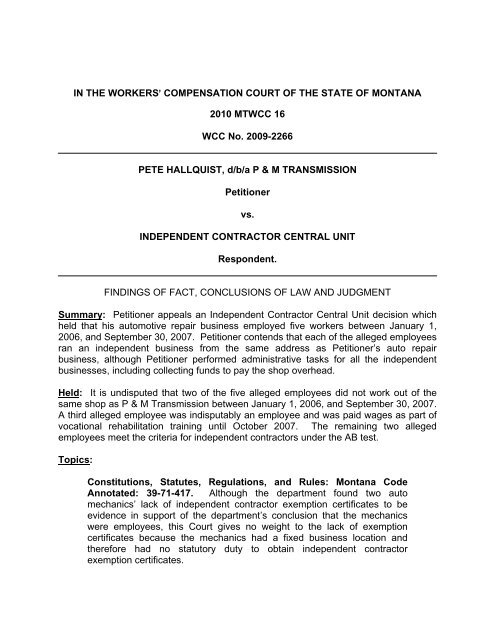
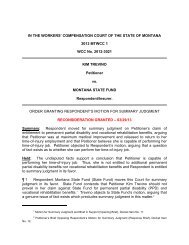
![Bustell v. AIG Claims Service, Inc. [05/03/05] 2005 MTWCC 23](https://img.yumpu.com/49777654/1/190x245/bustell-v-aig-claims-service-inc-05-03-05-2005-mtwcc-23.jpg?quality=85)
![Vallance v. MCCF [07/05/06] 2006 MTWCC 26 - Workers ...](https://img.yumpu.com/48724322/1/190x245/vallance-v-mccf-07-05-06-2006-mtwcc-26-workers-.jpg?quality=85)
